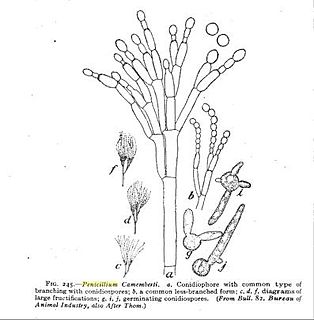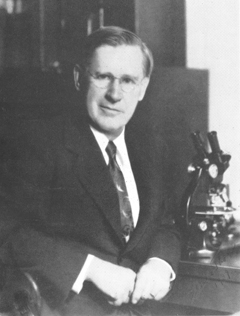
A mold or mould is a fungus that grows in the form of multicellular filaments called hyphae. In contrast, fungi that can adopt a single-celled growth habit are called yeasts.

The glucose oxidase enzyme (GOx) also known as notatin is an oxido-reductase that catalyses the oxidation of glucose to hydrogen peroxide and D-glucono-δ-lactone. This enzyme is produced by certain species of fungi and insects and displays antibacterial activity when oxygen and glucose are present.

Penicillium roqueforti is a common saprotrophic fungus in the genus Penicillium. Widespread in nature, it can be isolated from soil, decaying organic matter, and plants.

Penicillium camemberti is a species of fungus in the genus Penicillium. It is used in the production of Camembert, Brie, Langres, Coulommiers, and Cambozola cheeses, on which colonies of P. camemberti form a hard, white crust. It is responsible for giving these cheeses their distinctive flavors. An allergy to the antibiotic penicillin does not necessarily imply an allergy to cheeses made using P. camemberti.

The history of penicillin follows a number of observations and discoveries of apparent evidence of antibiotic activity in molds before the modern isolation of the chemical penicillin in 1928. There are anecdotes about ancient societies using molds to treat infections, and in the following centuries many people observed the inhibition of bacterial growth by various molds. However, it is unknown if the species involved were Penicillium species or if the antimicrobial substances produced were penicillin.

Penicillium chrysogenum or P. notatum (formerly) is a species of fungus in the genus Penicillium. It is common in temperate and subtropical regions and can be found on salted food products, but it is mostly found in indoor environments, especially in damp or water-damaged buildings. It was previously known as Penicillium notatum. It has rarely been reported as a cause of human disease. It is the source of several β-lactam antibiotics, most significantly penicillin. Other secondary metabolites of P. chrysogenum include roquefortine C, meleagrin, chrysogine, 6-MSA YWA1/melanin, andrastatin A, fungisporin, secalonic acids, sorbicillin, and PR-toxin.

Charles Thom was an American microbiologist and mycologist. Born and raised in Illinois, he received his PhD from the University of Missouri, the first such degree awarded by that institution. He was best known for his work on the microbiology of dairy products and soil fungi, and in particular his research into the genera Aspergillus and Penicillium. His work influenced the establishment of standards for food handling and processing in the USA. He pioneered the use of culture media to grow microorganisms, and, with food chemist James N. Currie, developed a process to mass-produce citric acid using Aspergillus. Thom played an important role in the development of penicillin in World War II.
Penicillium allii-sativi is a fungus species of the genus Penicillium, section Chrysogena. It is one of several Penicillium species that can produce penicillin in culture. The fungus has been found in Argentina, Bulgaria, France, Portugal, South Africa, and the United Kingdom. The specific epithet allii-sativi refers to the garlic plant, Allium sativum, from which the fungus was isolated.
Penicillium vanoranjei is an orange-colored fungus first described in 2013 from specimens collected in Tunisia. It was named after the Prince of Orange Willem-Alexander to commemorate his coronation as King of the Netherlands.
Penicillium desertorum is a species of the genus of Penicillium which was isolated from desert soil under the plant Oryzopsis hymenoides in Wyoming in the US.
Penicillium dipodomyis is a species of the genus of Penicillium which occurs in kangaroo rats and produces penicillin and the diketopiperazine dipodazine.
Penicillium flavigenum is a species of the genus of Penicillium which produces penitrem A, penicillin and roquefortine C.
Penicillium goetzii is a species of the genus of ascomycetous fungi.
Penicillium halotolerans is a species of the genus of Penicillium which has the ability to tolerate 5% NaCl.
Penicillium mononematosum is an anamorph species of the genus Penicillium which produces viriditoxin.
Penicillium nalgiovense is an anamorph species of the genus Penicillium with lipolytic and proteolytic activity, which was first isolated from ellischau cheese. This species produces dichlorodiaportin, diaportinol, and diaportinic acid Penicillium nalgiovense is used for the maturation of certain fermented salami varieties and ham. In this process it protects the meat from colonization by other molds and bacteria
Penicillium tardochrysogenum is a filamentous species of fungus in the genus Penicillium which produces penicillin, secalonic acids D and secalonic acids F.
Penicillium commune is an indoor fungus belonging to the genus of Penicillium. It is known as one of the most common fungi spoilage moulds on cheese. It also grows on and spoils other foods such as meat products and fat-containing products like nuts and margarine. Cyclopiazonic acid and regulovasine A and B are the most important mycotoxins produced by P. commune. The fungus is the only known species to be able to produce both penitrem A and roquefortine. Although this species does not produce penicillin, it has shown to have anti-pathogenic activity. There are no known plant, animal or human diseases caused by P. commune.







